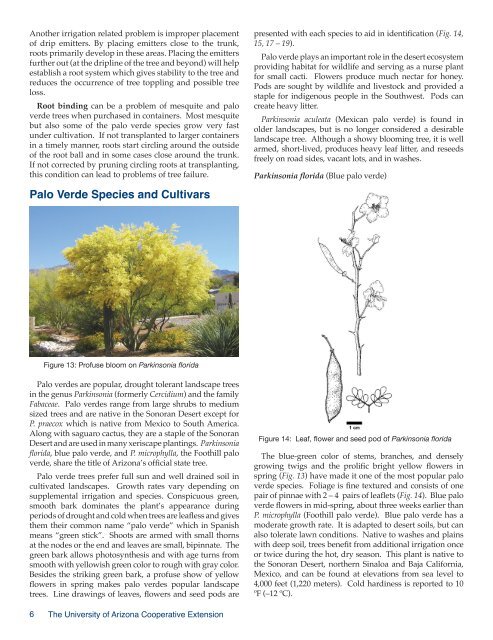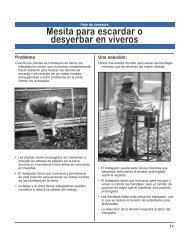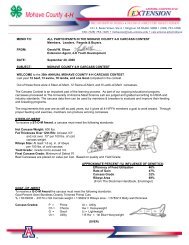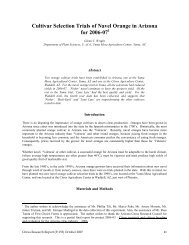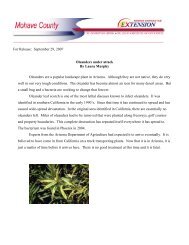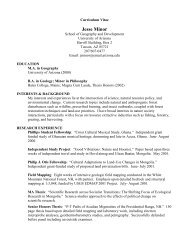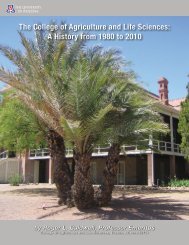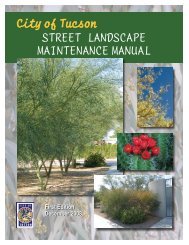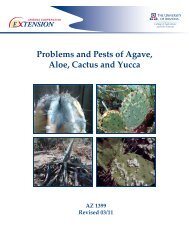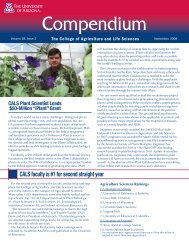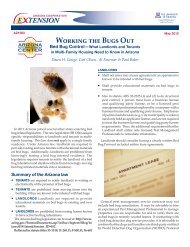Mesquite and Palo Verde Trees - University of Arizona
Mesquite and Palo Verde Trees - University of Arizona
Mesquite and Palo Verde Trees - University of Arizona
You also want an ePaper? Increase the reach of your titles
YUMPU automatically turns print PDFs into web optimized ePapers that Google loves.
Another irrigation related problem is improper placement<br />
<strong>of</strong> drip emitters. By placing emitters close to the trunk,<br />
roots primarily develop in these areas. Placing the emitters<br />
further out (at the dripline <strong>of</strong> the tree <strong>and</strong> beyond) will help<br />
establish a root system which gives stability to the tree <strong>and</strong><br />
reduces the occurrence <strong>of</strong> tree toppling <strong>and</strong> possible tree<br />
loss.<br />
Root binding can be a problem <strong>of</strong> mesquite <strong>and</strong> palo<br />
verde trees when purchased in containers. Most mesquite<br />
but also some <strong>of</strong> the palo verde species grow very fast<br />
under cultivation. If not transplanted to larger containers<br />
in a timely manner, roots start circling around the outside<br />
<strong>of</strong> the root ball <strong>and</strong> in some cases close around the trunk.<br />
If not corrected by pruning circling roots at transplanting,<br />
this condition can lead to problems <strong>of</strong> tree failure.<br />
<strong>Palo</strong> <strong>Verde</strong> Species <strong>and</strong> Cultivars<br />
Figure 13: Pr<strong>of</strong>use bloom on Parkinsonia florida<br />
<strong>Palo</strong> verdes are popular, drought tolerant l<strong>and</strong>scape trees<br />
in the genus Parkinsonia (formerly Cercidium) <strong>and</strong> the family<br />
Fabaceae. <strong>Palo</strong> verdes range from large shrubs to medium<br />
sized trees <strong>and</strong> are native in the Sonoran Desert except for<br />
P. praecox which is native from Mexico to South America.<br />
Along with saguaro cactus, they are a staple <strong>of</strong> the Sonoran<br />
Desert <strong>and</strong> are used in many xeriscape plantings. Parkinsonia<br />
florida, blue palo verde, <strong>and</strong> P. microphylla, the Foothill palo<br />
verde, share the title <strong>of</strong> <strong>Arizona</strong>’s <strong>of</strong>ficial state tree.<br />
<strong>Palo</strong> verde trees prefer full sun <strong>and</strong> well drained soil in<br />
cultivated l<strong>and</strong>scapes. Growth rates vary depending on<br />
supplemental irrigation <strong>and</strong> species. Conspicuous green,<br />
smooth bark dominates the plant’s appearance during<br />
periods <strong>of</strong> drought <strong>and</strong> cold when trees are leafless <strong>and</strong> gives<br />
them their common name “palo verde” which in Spanish<br />
means “green stick”. Shoots are armed with small thorns<br />
at the nodes or the end <strong>and</strong> leaves are small, bipinnate. The<br />
green bark allows photosynthesis <strong>and</strong> with age turns from<br />
smooth with yellowish green color to rough with gray color.<br />
Besides the striking green bark, a pr<strong>of</strong>use show <strong>of</strong> yellow<br />
flowers in spring makes palo verdes popular l<strong>and</strong>scape<br />
trees. Line drawings <strong>of</strong> leaves, flowers <strong>and</strong> seed pods are<br />
6 The <strong>University</strong> <strong>of</strong> <strong>Arizona</strong> Cooperative Extension<br />
presented with each species to aid in identification (Fig. 14,<br />
15, 17 – 19).<br />
<strong>Palo</strong> verde plays an important role in the desert ecosystem<br />
providing habitat for wildlife <strong>and</strong> serving as a nurse plant<br />
for small cacti. Flowers produce much nectar for honey.<br />
Pods are sought by wildlife <strong>and</strong> livestock <strong>and</strong> provided a<br />
staple for indigenous people in the Southwest. Pods can<br />
create heavy litter.<br />
Parkinsonia aculeata (Mexican palo verde) is found in<br />
older l<strong>and</strong>scapes, but is no longer considered a desirable<br />
l<strong>and</strong>scape tree. Although a showy blooming tree, it is well<br />
armed, short-lived, produces heavy leaf litter, <strong>and</strong> reseeds<br />
freely on road sides, vacant lots, <strong>and</strong> in washes.<br />
Parkinsonia florida (Blue palo verde)<br />
Figure 14: Leaf, flower <strong>and</strong> seed pod <strong>of</strong> Parkinsonia florida<br />
The blue-green color <strong>of</strong> stems, branches, <strong>and</strong> densely<br />
growing twigs <strong>and</strong> the prolific bright yellow flowers in<br />
spring (Fig. 13) have made it one <strong>of</strong> the most popular palo<br />
verde species. Foliage is fine textured <strong>and</strong> consists <strong>of</strong> one<br />
pair <strong>of</strong> pinnae with 2 – 4 pairs <strong>of</strong> leaflets (Fig. 14). Blue palo<br />
verde flowers in mid-spring, about three weeks earlier than<br />
P. microphylla (Foothill palo verde). Blue palo verde has a<br />
moderate growth rate. It is adapted to desert soils, but can<br />
also tolerate lawn conditions. Native to washes <strong>and</strong> plains<br />
with deep soil, trees benefit from additional irrigation once<br />
or twice during the hot, dry season. This plant is native to<br />
the Sonoran Desert, northern Sinaloa <strong>and</strong> Baja California,<br />
Mexico, <strong>and</strong> can be found at elevations from sea level to<br />
4,000 feet (1,220 meters). Cold hardiness is reported to 10<br />
ºF (–12 ºC).


